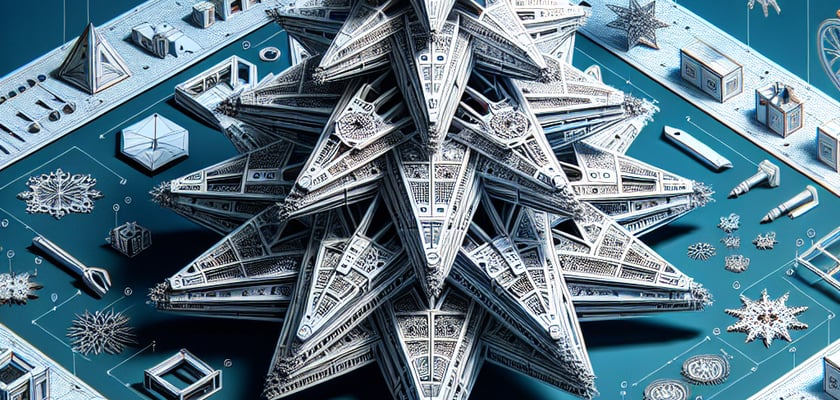If you thought regular origami was a holiday challenge, brace yourself for the Everest of crafting: 3D Paper Christmas Tree Engineering. This festive physics-defying feat takes paper folding to a whole new dimension – literally. It’s the art of turning a humble flat sheet of paper into a popping pine that could stand toe-to-toe with your average Nutcracker soldier. This methodical madness isn’t just about bending paper to your holiday will; it’s an intricate blend of geometry, patience, and the kind of dexterity usually reserved for card sharks and brain surgeons.
Now, I know what you’re thinking: “But why would I spend hours crafting a tiny tree when there’s a perfectly good plastic one in the attic?” Ah, grasshopper, because the satisfaction you’ll get from engineering this sapling is greater than finding the last chocolate in the advent calendar. Plus, impressing your in-laws with a DIY masterpiece is just icing on the (fruit)cake. In the sprightly spruce sections to come, we’ll delve into the mystical world of folding techniques, paper types, and decoration tips — because a naked tree is just a botanical faux pas. Grab your rulers and craftiest scissors, reindeer amigos; it’s time to transform your living room into a tiny Yuletide timberland.
Key points I covered in this post
1. 3D paper Christmas trees are a creative and accessible holiday craft that can engage individuals and families in applied engineering practices. The process involves designing, cutting, folding, and assembling paper to create three-dimensional shapes, which can be tailored to various skill levels and ages, making this activity inclusive for a broad audience.
2. The engineering principles underlying the creation of a 3D paper Christmas tree include spatial reasoning, geometry, and structural design. These principles allow for the conversion of a two-dimensional material, like paper, into a stable, self-standing, three-dimensional object through careful planning and execution.
3. The design process typically involves brainstorming ideas, sketching prototypes, and experimenting with different cuts, folds, and attachments. Precision is key in this process as the accuracy of cuts and folds directly impacts the tree’s ability to stand and bear additional decorations such as ornaments or garlands.
4. Technical skills such as drafting and the use of tools like scissors, craft knives, or cutting machines are developed through creating 3D paper Christmas trees. These craft projects can also serve as an educational platform for teaching basic engineering and design concepts, potentially sparking interest in STEM fields.
5. Environmental sustainability can be considered in 3D paper Christmas tree engineering by selecting eco-friendly materials such as recycled paper, using minimal adhesive, and encouraging reuse of the trees. This approach allows the craft to be not only a festive decoration but also an opportunity to promote eco-consciousness during the holiday season.
How does one engineer a 3D Paper Christmas Tree? To engineer a 3D paper Christmas tree, you must first select a suitable paper material, such as cardstock or heavy craft paper, for its ability to hold shape and maintain structure. The process involves creating a template, which typically consists of a series of identical, symmetrical panels that will form the tree’s conical shape when joined together. **Each panel has interlocking slots** cut into them, which when assembled, will allow the panels to stand upright without the need for adhesives. The base of the tree must be weighted or designed in such a way to provide stability, and optionally, additional decorations or textures can be added to enhance the tree’s aesthetic appeal.
Materials and Tools Required for 3D Paper Christmas Tree Construction
To begin crafting a 3D paper Christmas tree, one will need several materials and tools. Necessary supplies include:
- Cardstock or heavy craft paper – for sturdy construction.
- Scissors or a craft knife – for precise cutting.
- A cutting mat – to protect surfaces during cutting.
- A straight edge or ruler – to ensure accurate, straight lines.
- A pencil – for marking out your template on the paper.
- Adhesive (optional) – some designs may require glue.
Designing the Template for a 3D Paper Christmas Tree
To create a symmetrical and well-proportioned tree, one must design or download a template. The template typically consists of a star-shaped base with interconnecting panels for the tree. Each panel should be designed with slots that match up to allow for easy assembly. The number of panels will dictate the fullness of the tree – more panels result in a denser tree, while fewer panels give a more open look.
Assembly Instructions for a 3D Paper Christmas Tree
The assembly process is crucial to the stability and appearance of the 3D paper Christmas tree. After all the components are cut out, follow these steps:
- Begin by folding each panel along the predetermined lines.
- Interlock the panels using the slots to form the tree’s conical shape.
- If necessary, use adhesive to secure the panels in place.
- Ensure the base is flat and stable to prevent the tree from toppling over.
- Add the final touches, such as a paper star or baubles made from paper or other decorative elements.
Decoration and Customization of Your 3D Paper Christmas Tree
A plain 3D paper Christmas tree can be transformed into a personalized holiday decoration through various embellishments. Ideas for customization include glitter, paint, or festive paper patterns for crafting the panels. Adding LED string lights or paper garlands also enhances the overall appearance, giving the tree a festive glow.
Troubleshooting Common Issues in 3D Paper Christmas Tree Assembly
There are several common issues that may arise during the construction of a 3D paper Christmas tree. Panels may not align correctly, which can be fixed by ensuring precision during the cutting and folding stages. If the tree lacks stability, reinforce the base by adding weight or widening it. Should the tree lean, re-adjust the slots and tabs for a more secure fit.
Are there tips for ensuring a stable and aesthetically pleasing 3D paper Christmas tree?
- Use thick paper or cardstock to prevent collapse under its own weight.
- Ensure all cuts and folds are precise for seamless assembly.
- Decorate the tree components before assembly to avoid damaging the structure.
- Balance the base sufficiently to avoid any tilting of the completed tree.
- Explore various tree sizes – smaller trees can make charming table decorations, while larger versions can be impressive floor displays.
- Experiment with different colors and textures of paper to create unique designs.
- Remember to store your template for future use or to share with others.
What is 3D Paper Christmas Tree Engineering?
3D Paper Christmas Tree Engineering is a creative process that involves designing and constructing three-dimensional Christmas trees out of paper. This encompasses a variety of techniques such as folding, cutting, and assembling to create a festive decoration. The complexity of the design can vary, from simple models that are suitable for craft beginners to intricate patterns that require precise cutting and folding skills.
What materials are needed for creating a 3D Paper Christmas Tree?
To create a 3D Paper Christmas Tree, you will generally need construction paper or cardstock as your base material. Additionally, you might require a cutting tool like scissors or a craft knife, an adhesive such as glue or double-sided tape, and any additional decorative elements like glitter, paint, or markers to personalize your tree. Some projects may also include instructions for the use of scoring tools or rulers to help create precise folds and cuts.
How can I ensure my 3D Paper Christmas Tree is stable?
Stability in 3D paper constructs is primarily achieved by designing a sturdy base and using quality materials. When constructing your tree, make sure to balance the tree properly and consider reinforcing the base with additional layers of paper or using a heavier stock of paper. Properly scored folds and secure adhesive connections are also key to ensuring your tree can stand without support.
Are there templates available for 3D Paper Christmas Trees?
Yes, there is a myriad of templates available for 3D Paper Christmas Trees that cater to various skill levels and design preferences. These templates can be found in craft books, online crafting sites, or as downloadable content from arts and crafts blogs. Templates can greatly simplify the construction process, providing you with exact patterns to cut and fold, which is especially helpful for beginners.
Can 3D Paper Christmas Trees be recycled?
3D Paper Christmas Trees made from paper can generally be recycled after use, provided that they do not have non-paper embellishments such as plastic glitter or metal fasteners. If you want to ensure that your craft is as eco-friendly as possible, opt for recyclable paper and decorations, and avoid using materials that might complicate the recycling process.
Final Thoughts
3D Paper Christmas Tree Engineering can be an extremely rewarding activity, bringing a touch of handmade charm and personalization to the holiday season. Not only does this craft offer an eco-friendly alternative to conventional decorations, but it also provides a fantastic opportunity to engage in creative expression and problem-solving. Whether you are a seasoned crafter or a newcomer to paper engineering, creating a 3D Paper Christmas Tree can be a fun project that inspires innovation and a sense of accomplishment.
Fostering a tradition of crafting your paper decorations can make holiday preparations more intimate and family-centered. It encourages participation from people of all ages, and the end result is a unique Christmas display that holds more sentimental value than store-bought decor. Furthermore, by promoting sustainable practices, such as using recyclable materials and creating decorations that can be used year after year, we can make our holidays a little greener, one paper tree at a time.

